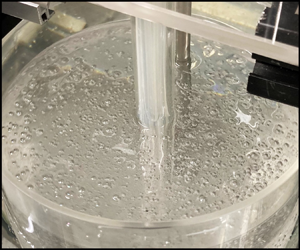No CrossRef data available.
Article contents
Rheology of dilute bubble suspensions in unsteady shear flows
Published online by Cambridge University Press: 21 March 2024
Abstract

The viscoelasticity of a dilute bubble suspension is theoretically derived from the constitutive equation originally for a dilute emulsion proposed by Frankel & Acrivos (J. Fluid Mech., vol. 44, issue 1, 1970, pp. 65–78). Non-dimensionalization of the original tensor equation indicates that the viscoelasticity is systematized for a given void fraction by the capillary number  $Ca$ and dynamic capillary number
$Ca$ and dynamic capillary number  $Cd$, representing the bubble deformability and unsteadiness of bubble deformation. Comprehensive evaluation of the viscoelasticity according to the volume fraction,
$Cd$, representing the bubble deformability and unsteadiness of bubble deformation. Comprehensive evaluation of the viscoelasticity according to the volume fraction,  $Ca$ and
$Ca$ and  $Cd$ reveals that whether the viscosity increases or decreases depends on whether
$Cd$ reveals that whether the viscosity increases or decreases depends on whether  $Ca$ or
$Ca$ or  $Cd$ exceeds a common critical value. In addition, it is indicated that the bubble suspension has the most prominent viscoelasticity when the time scale of the shear deformation is the same as the relaxation time of the suspended bubble and when the bubbles keep a spherical shape, that is,
$Cd$ exceeds a common critical value. In addition, it is indicated that the bubble suspension has the most prominent viscoelasticity when the time scale of the shear deformation is the same as the relaxation time of the suspended bubble and when the bubbles keep a spherical shape, that is,  $Ca \ll 1$ and
$Ca \ll 1$ and  $Cd = 1$. The applicability of this theory in flow prediction was examined in a Taylor–Couette system, and experimentally good agreement was confirmed.
$Cd = 1$. The applicability of this theory in flow prediction was examined in a Taylor–Couette system, and experimentally good agreement was confirmed.
- Type
- JFM Papers
- Information
- Copyright
- © The Author(s), 2024. Published by Cambridge University Press





